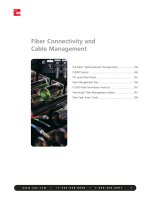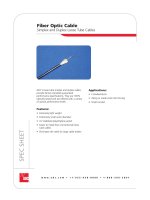Cable Management and Slack Storage
Bạn đang xem bản rút gọn của tài liệu. Xem và tải ngay bản đầy đủ của tài liệu tại đây (165.43 KB, 4 trang )
Cable Management and
Slack Storage
WHITE PAPER
Taking Up the Slack in Cable Management
Over the years, more and more people have become experienced in working with optical
fiber, particularly in the central office (CO) environment. One bit of knowledge obtained
quickly through experience is the importance of fiber cable management and how it can
dramatically affect the operational costs of a network. ADC has a wealth of experience
in the areas of cable management and slack storage systems that are time-tested and
continually improved – but it all begins with pure awareness.
Storing excess fiber cable is an often overlooked area within the fiber-to-the-premise
(FTTP) network’s outside plant (OSP) architecture, yet it is critical when it comes to
preventing cable management problems. For example, excess patch cord fiber is usually
necessary for reconfiguring a fiber circuit, but the slack must be managed to prevent
damage. At the same time, all fibers should remain as accessible as possible during day-
to-day operations of the network.
Accessibility and the amount of time required to reconfigure a network will be optimized
in a system that maintains a continuous non-coiled or twisted routing of the fibers. The
successful slack storage system provides flexible storage capacities, permanent bend
radius protection, and easy access to individual fibers. It will also mitigate many potential
problems that non-managed systems could face over time.
Keys to Unlocking Fiber Management
Good fiber cable management can be broken down into a few key principles. The first
principle is to develop clear routing paths that are obvious to any technician at a
glance. In other words, routing the fiber correctly should be intuitive and easily
accomplished. Next, fiber cable should be physically protected to prevent damage as a
result of technicians working on other parts of the cabinet or cable management
device. Measures should be taken to avoid damaging, pulling, stretching, crushing or
pinching existing fibers in the vicinity of the work area.
Another key to cable management is bend radius protection. As fiber is bent, the
radius can become too small and allow light to escape the core and enter the
cladding. The result is insertion loss in the fiber or a macrobend that decreases the
signal or, in extreme cases, causes complete signal loss and data transfer failures.
Finally, an integrated slack storage strategy or system is necessary. Each fiber, due to
the high tolerance needed, is normally terminated in the factory to eliminate the high
costs involved with field terminations. This typically results in fixed cable lengths and
patch cords. Once the technician arrives at the job site to make a connection, the fiber
cable or patch cord may be longer than what is actually required. Therefore, a system
must allow the proper storage of the slack – the difference in length between what is
actually needed to physically make the connection, and what the technician actually
has to work with.
Cable Management and Slack Storage
Cable Management and Slack Storage
Page 3
These storage management principles have evolved
within the CO environment for making a network both
reliable and operationally efficient. Now that fiber is
being pushed deeper into the access network,
particularly as fiber-to-the-premise (FTTP) architectures
begin to deploy, these same principles will apply to
ensure the operational efficiency of the access portion
as well.
Although many may be less inclined to realize the
importance of cable management in the access
network due to less data traveling across a single fiber,
it’s critical to realize that far more fibers are being
deployed in comparison to the core network.
Therefore, individual management of fiber becomes
even more important since each fiber’s reliability is
directly tied to customer satisfaction.
CO Techniques Outside the CO
Since the fiber distribution hub in the access network’s
outside plant is very similar to a CO’s fiber frame device,
it makes sense that the same cable management
techniques should be put into practice. But since the
fiber distribution panel is located in the middle of a
neighborhood, environmental issues must also be
considered. Additionally, a single technician is likely to
have many different responsibilities while not specializing
in how a particular piece of equipment operates. This
scenario generates an even greater need for effectively
dealing with fiber cable management issues.
For example, when the technician arrives at the
distribution cabinet, he may not be familiar with exactly
how previous fiber cables and connections have been
made. In fact, it could be the first time he’s opened this
particular cabinet. With that in mind, it’s easy to see the
importance of a system that not only achieves routing
paths that are intuitive, easy to find, and clear, there
should also be documentation right at the point of use
that enables the technician to remember and implement
standard cable management techniques.
Outside temperature variations also can cause fiber cable
management issues. Although the fiber isn’t affected by
fluctuating temperatures, the jacketing materials can
shrink and expand, causing bend radius problems.
Technicians must ensure all fiber cables are constrained
around the bend radius while permitting shrinkage in
cold temperatures.
Other less common scenarios, yet still worthy of
consideration, might include the possibility of having to
completely restore a fiber distribution cabinet that was
struck by a vehicle. Is there a plan in place for quickly
restoring or replacing the cabinet? Typically, this involves
having some coils of slack storage below the ground or
up on a pole that allows replacement of the entire
cabinet or modular items within the cabinet.
In a typical FTTP architecture, it is often common to place
only half the terminations within the distribution cabinet
and allow for future expansion. The cable management
system should be adaptable to routing any splitter port
to any connector port, making it easy to add more
connections without affecting the cable management
that exists for the original fibers.
In fact, the ability to route from any splitter port to any
distribution port is a key issue within the cabinet. Making
sure the cable management is in place to support the
clear routing paths, store slack cable, provide physical
protection, and achieve proper bend radius protection
from day one to several years after deployment will
provide operational cost savings for the service provider.
Getting to Every Connector
Finally, easy connector access is a vital part of any cable
management system. Technicians should be able to
access any individual connector for cleaning,
maintenance, and troubleshooting. Cleaning connector
endfaces is no less important in the access network than
in the CO environment. A small speck of dust on an
endface can jeopardize a successful optical connection.
Since many of the access network connections are made
in the outside plant portion of the network, there is wind
and contaminants to raise the probability of an exposed
endface attracting debris. Therefore, cleaning both the
front and rear connections in the panel is necessary and
requires adequate access. Dust covers on the connectors
and adaptors are designed for keeping debris off the
endface, but they are always dependent on how
technicians use them. Dust covers never negate the need
for cleaning each time a connection is made.
Typically, some slack fiber is left on the backside of a
patch panel in the event of a failed or broken connector
or fiber. This enables the opportunity to restore service to
the cabinet by having extra fiber to use. There should be
a place for storing a number of splices and a way to
access that area – along with extra slack cable that
enables quick restoration when necessary.
Fiber cable management techniques play as important a
role in the access network as they have traditionally
played in the CO. The fiber distribution hub is a
particularly crucial area due to the large number of
connections and fibers present.
However, other areas that deserve consideration for cable
management include the fiber access terminals farther up
the access network. Here again, the same key techniques
apply for cable routing, slack storage, physical protection,
and bend radius considerations. Additionally, the
optical network terminal (ONT) at the extreme end
of the network, although only dealing with one or
two fibers, is also a candidate for bend radius and
physical protection issues.
ADC believes that proper cable management
techniques will optimize access networks in terms
of accessibility and the amount of time required to
reconfigure a network. Successful cable
management is key to eliminating many potential
problems that non-managed systems will likely
face in their future.
ADC Telecommunications, Inc., P.O. Box 1101, Minneapolis, Minnesota USA 55440-1101
Specifications published here are current as of the date of publication of this document. Because we are continuously
improving our products, ADC reserves the right to change specifications without prior notice. At any time, you
may verify product specifications by contacting our headquarters office in Minneapolis. ADC Telecommunications,
Inc. views its patent portfolio as an important corporate asset and vigorously enforces its patents. Products or
features contained herein may be covered by one or more U.S. or foreign patents. An Equal Opportunity Employer
103779AE 11/06 Revision © 2005, 2006 ADC Telecommunications, Inc. All Rights Reserved
Web Site: www.adc.com
From North America, Call Toll Free: 1-800-366-3891 • Outside of North America: +1-952-938-8080
Fax: +1-952-917-3237 • For a listing of ADC’s global sales office locations, please refer to our web site.
WHITE PAPER









